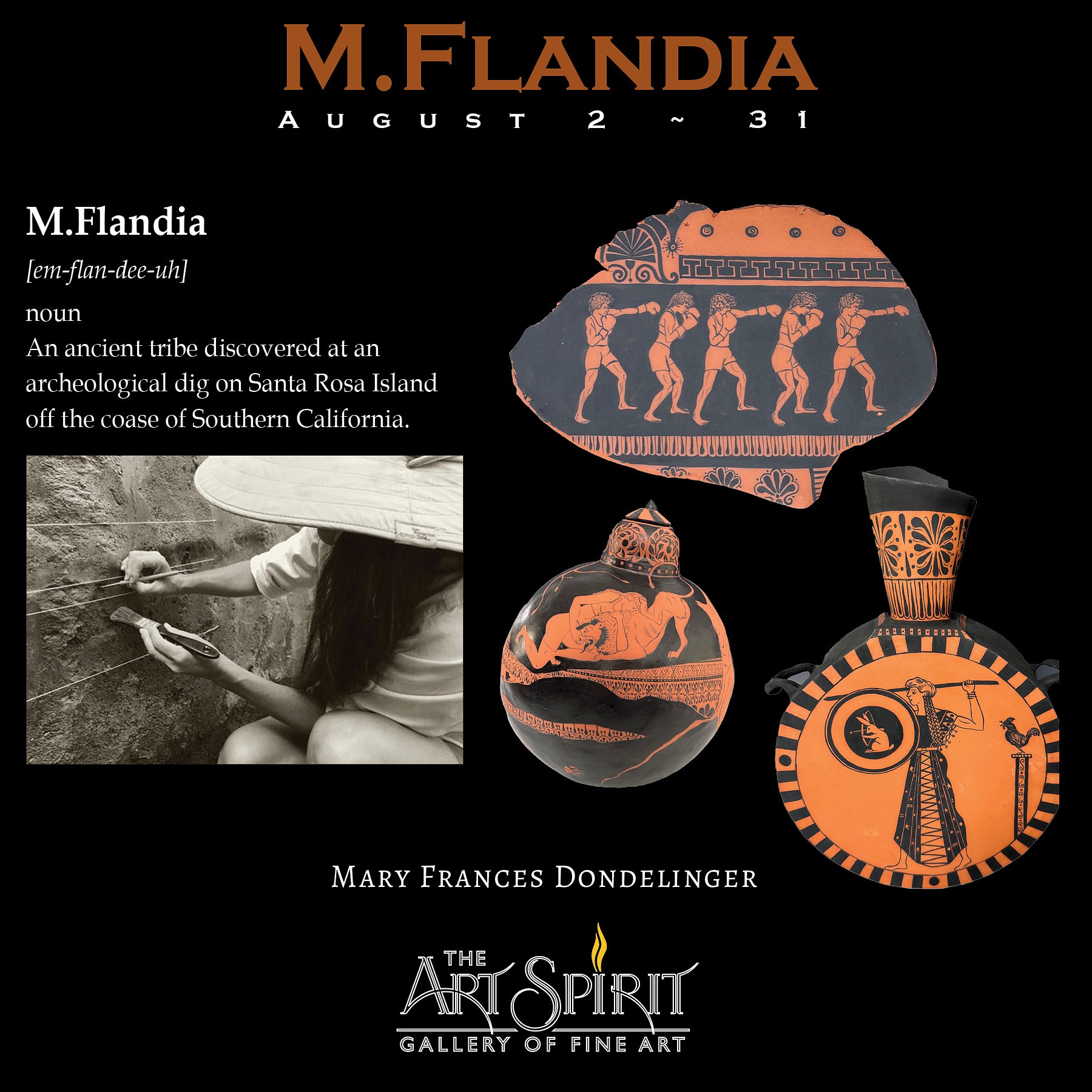PRESS RELEASE

In this post-truth era comes a discovery so big, so unbelievable, it’s got to be true.
ANCIENT SOCIETY DISCOVERED IN SOUTHERN CALIFORNIA
Discovered 12 meters (40 ft) below the surface in the Santa Rosa Island region, this rare and unprecedented archeological cache of pottery and sculpture belonging to a previously unknown society has flummoxed the archeological community. Some scientists debate the authenticity of this find because of the apparent gender equality. But artist MF Dondelinger says sometimes it’s hard to get our minds around new concepts and images to understand their meanings. “What we need now is to be open to interpreting this unusual society. I think it requires a whole paradigm shift on how some early communities are interpreted.”
This agrarian village-based society is called M.flandia (Em-flan-dia) and questions arise not of its origin or time of existence but its societal structure.
Many are familiar with the classic Greek urns featuring athletic male bodies prancing across the surface. In M.flandia, similar decorative artistic styles are employed however the imagery suggests strong female participation in society. Women are shown as being active, athletic, as warriors, and as intellects.
One sculpture found nearly intact is called the “Goddess of Strength”. She stands 70 cm tall (24 inches) with open arms. Instead of the traditional multiple breasts to symbolize a fertility goddess, she has boxing gloves ballooning off her chest. Below animals of the earth line her dress. It is possible she symbolizes the hunter, or protector of the earth or perhaps the animals represent wealth and this sculpture is symbolizing her strength and power. Archeologists are not certain at this early point in research.
The male role has been symbolized in the Aquatic God of Fertility. The complete sculpture could not be salvaged but a very fine specimen of the head was recovered. His young face suggests the strength of youth and beauty. His coral-like hair is swept up in a phallic-like shape ready for action. Swimming fish sculptures were found near this important artefact. A noted oddity is the pure and powerful blue glaze used on the hair and rarely available in the Americas. It suggests an influence of travelers from Asia after the 1400’s.
“It’s not clear that it was specifically a matriarchal or patriarchal society but certainly both men and women’s role in village life were considered important and perhaps equal, states an anonymous source close to the discovery site who is not authorized to speak about the site or specific discoveries.
Fragments as well as whole intact pieces have been unearthed and are being studied and processed for continued research and public viewing.
The Art Spirit Gallery will exhibit a small sampling of this early history for a limited time only.
_________
Mary Frances Dondelinger
Mary Frances Dondelinger is an acclaimed artist, iconographer, and storyteller whose work marries ancient traditions with contemporary themes. Based in Coeur d’Alene, Idaho, and Tucson, Arizona, she weaves historical sacred art with modern social commentary, creating powerful visual allegories that explore humanity’s anxieties, motivations, and environmental concerns. Her innovative approach often juxtaposes the sacred with the disposable, using humble materials like paper plates and gold leaf to highlight the fragility and resilience of both culture and nature.
A recipient of numerous awards and grants, including NEA funding and international exhibitions, Dondelinger’s work has been celebrated worldwide—most notably in Vienna’s Belvedere Palace Museum. Her studio practice is rooted in deep study of orthodox iconography, with extensive apprenticeships in Italy and through online mentorships, blending sacred craft with urgent contemporary discourse. Her latest series, M.Flandia, invites viewers to reconsider assumptions about societal structure and gender roles through archeological mystery and symbolic sculpture.
Artist Statement
“In a time plagued by post-truth narratives, I am drawn to the discovery of M.flandia, an ancient society hidden beneath the surface of Southern California’s shores, challenging our perceptions of history, gender, and societal harmony. This exhibit explores the idea that understanding human history often requires a paradigm shift—embracing new images and concepts that defy conventional wisdom. My work focuses on this imagined society’s residents—powerful women, active warriors, and equally significant men—whose roles suggest a society rooted in gender balance and collective strength. Through iconography and allegory, I aim to provoke dialogue about the nature of human community, the power of representation, and the stories we tell ourselves about our origins.
In M.Flandia, I use historical symbolism to question contemporary assumptions and inspire viewers to see behind the surface—recognizing that truth often lies beneath layers of myth, mystery, and interpretation.”
